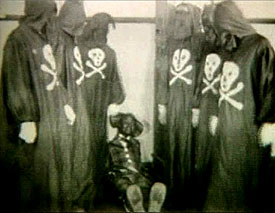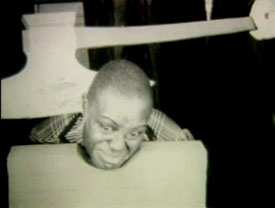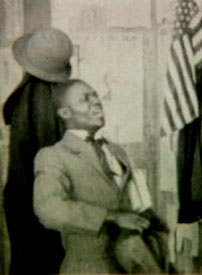"An Ebony Film" entitled Spying the Spy (1918) is one of the earliest surviving films from a production company specializing in films for black-owned cinema houses. It is predated by Two Knights of Vaudeville (1913).
Most of Chicago's Ebony Film company's movies do not survive, though more may exist in private collections & will one day come to light.
The studio was first established in 1915 as the Historical Feature Film Company. The white-owned studio made slapstick comedies for black audiences. Their first films were so horrendous at perpetuating the worst stereotypes that they were boycotted by the black audiences of Chicago, without whose support the films could not be profitable.
So in 1917 the company "regrouped" as Ebony Films, bringing in black directors like L. J. Pollard, & black scenarists, who were much more capable of paying attention to & understanding the criticisms & outrage generated in the black community by D. W. Griffith's Birth of a Nation (1915) which was so cavalier in treating the Ku Klux Klan as heroic, & Southern blacks as ape-like & oversexed.
To great extent the sudden flourishing of black-owned independent film companys after 1915 (there were about thirty at their height of activity) was due to the abject need to provide something for black audiences that countered Griffith's unfortunate classic.
There was an even earlier film company specializing in race films, Foster Photoplay Company founded by black vaudevillian William Foster in 1910, but so far as I've been able to ascertain, his films haven't survived.
 Spying the Spy is one-reel silent spy spoof opens with a front page newspaper headline" "Sambo Sam Captures Single Handed a Nest orf Spies," including a picture of the snappily dressed Sam. Spying the Spy is one-reel silent spy spoof opens with a front page newspaper headline" "Sambo Sam Captures Single Handed a Nest orf Spies," including a picture of the snappily dressed Sam.
The name "Sambo" no more than the equally ill-considered stage name of Steppin Fetchit was not considered quite so offensive in the day, played by Samuel "Sambo" Jacks, the primary comedy star for Ebony Films in 1917 & 1918, with a couple dozen films to his credit, mostly now lost. There was at least one earlier black star who controlled his image & product, notably Bert Williams in Natural Born Gambler (1916).
The support players for Spying the Spy the are of the George M. Lewis Stock Company & Ebony Players. George Lewis was himself a big star of variety shows & plays. One of the Lewis actors was Sam Robinson, brother of Bill "Bojangles" Robinson, who played a similar Sherlockian detective in the Ebony Films title A Black Sherlock Holmes (1918). The stage actors & vaudevillians who made up the two acting troups would not long use the names Ebony Players (fourteen players) or George Lewis Stock Company (twenty-six performers), but in years to come would continue to be seen in films of Oscar Michaux.
Jacks was vaudeville commedian who appeared exclusively to black audiences & never exposed whites to such stereotyping. Besides, Bannerman's racistly illustrated Little Black Sambo was not published in America until 1927, a caricature which Langston Hughes called "hurtful to black children," but which would not have had the same asssociation the name had for the next generation & all to follow.
As a bumbling easily frightened child-like adult, we could easily view the spy-hunting Sambo Sam as a demeaning stereotype rather than a vaudeville clown. Nevertheless, a by then sensitized black audience did feel insulted by the performance, & a film made with black neighborhoods in mind actually found a more receptive audience among white audiences of the year! Black audiences were able to compare Detective Sambo to the detective in John Edward Bruce's militantly race-proud The Black Sleuth (serialized in McGirt's Magazine, 1907-1909).
John Edward Bruce was active in Black Masonry (such as is spoofed in Spying the Spy) & he was a Black Nationalist orator & author of considerable intellectuality. He even espoused armed self-defense & black militia activity at a time when whites lynched blacks without fear of the law, making him a precursor to the Black Panthers.
Quite naturally lowbrow cinema did not live up to the model of John Edward Bruce's very politically motivated Yoruba American detective Sadipe. So audiences, encouraged by Chicago's black newspapers & ministers from their pulpits, assessed Sambo Sam still too much a minstrel show caricature; or, churches critical of race-films generally, regarded them too apt to be morally corrupting, so that women & children in particular were warned away. Chicago's activism against Ebony Films meant it closed down in 1919, having produced only twenty-one short films.
Yet when one realizes that "race" comedy this early in the cinematic era often boiled down to black men stealing chickens & eating watermelons (see for example The Watermelon Patch, 1905), it's comparatively advanced & prideful for a comedian to develop shtick requiring him, instead, to be a devoted patriot who loves his country's flag; a literate man familiar with the short stories of Arthur Conan Doyle; & a spy hunter who according the headline was not invariably misguided in his suspicions.
 In fact the model for Spying the Spy was the slapstick of Keystone Cops, not minstrel show stereotypes; & compared to the Keystone Cops, Sambo Sam is an intelligent & complex character. He's a handsome fellow, too, who looks a little bit like actor Andre Baugher from Homicide: Life in the Streets (1993-1998). In fact the model for Spying the Spy was the slapstick of Keystone Cops, not minstrel show stereotypes; & compared to the Keystone Cops, Sambo Sam is an intelligent & complex character. He's a handsome fellow, too, who looks a little bit like actor Andre Baugher from Homicide: Life in the Streets (1993-1998).
Young Sam reading about his own exploits in the paper is excited & inspired to put in another day of spy-hunting. Sucking a pipe like that of Sherlock Holmes, he follows a random German American about, considering the guy a spy because he's eating a German sausage & reading a newspaper in German.
He tracks the guy & with a big laundry sack captures him & takes him to "headquarters" where some white guys discover Sam has not captured an innocent German American after all, but has accidentally bagged "a respectable colored gentleman," who they release shortly after Sam is gone.
The respectable gentleman heads off to a lodge where he is slated to be initiated into the Order of the Mumbo Jumbo. A kind of Afro American Moose Lodge, the members get dressed up in black sheets & hoods with a death's head emblazoned on the front, & dance about absurdly. The intended initiate falls asleep & accidentally misses most of the silly rites that ensue.
Our would-be spy-hunter goes home to change into some fancier duds, including plaid pants & jacket, & a Sherlockian deerstalker cap. He continues his inept spy hunt, & soon realizes the Order of Mumbo Jumbo is very strange, thereby assuredly another nest of spies.
The lodge members set out to frighten the daylights out of their new initiate, but accidentally set their sites on the snooping Sam. With their black-hooded costumes, generally threatening posturing, & goofy parading about, Sam gets pretty darned scared, especially at the point when they begin to pretend they're going to chop his head off on a chopping block.
Before they can finish lopping off his head, there comes a knocking on the roof. The lodge members claim they are being "called" by their leader, & commit mass suicide, though only as a pretense, jumping up & laughing after Sam runs off. (As an aside, I was startled to realize suicide cults were well enough known in 1918 to be parodied in a silent movie; I kind of thought suicide cults were historically a more recent development.)
By then Sam's so frightened out of his wits that he's last seen running away down the railroad tracks out of town.
What a shame the rest of Samuel Jacks' films are lost or unavailable, because here is powerful evidence of a silent film commedian the equal of Fatty Arbuckle, Max Linder, Snub Pollard, John Bunny, Ben Turpin, or any number of better remembered comics of the era, & superior to the Keystone Cops. But without further evidence it's hard to say whether or not he might've equalled such extraordinary geniuses as Chaplin, Keaton, & Lloyd.
copyright © by Paghat the Ratgirl
|

 Spying the Spy is one-reel silent spy spoof opens with a front page newspaper headline" "Sambo Sam Captures Single Handed a Nest orf Spies," including a picture of the snappily dressed Sam.
Spying the Spy is one-reel silent spy spoof opens with a front page newspaper headline" "Sambo Sam Captures Single Handed a Nest orf Spies," including a picture of the snappily dressed Sam. In fact the model for Spying the Spy was the slapstick of Keystone Cops, not minstrel show stereotypes; & compared to the Keystone Cops, Sambo Sam is an intelligent & complex character. He's a handsome fellow, too, who looks a little bit like actor Andre Baugher from Homicide: Life in the Streets (1993-1998).
In fact the model for Spying the Spy was the slapstick of Keystone Cops, not minstrel show stereotypes; & compared to the Keystone Cops, Sambo Sam is an intelligent & complex character. He's a handsome fellow, too, who looks a little bit like actor Andre Baugher from Homicide: Life in the Streets (1993-1998).